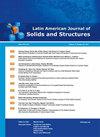Two accelerated isogeometric boundary element method formulations: fast multipole method and hierarchical matrices method
IF 1.1
4区 工程技术
Q3 ENGINEERING, CIVIL
引用次数: 0
Abstract
This work presents two fast isogeometric formulations of the Boundary Element Method (BEM) applied to heat conduction problems, one accelerated by Fast Multipole Method (FMM) and other by Hierarchical Matrices. The Fast Multipole Method uses complex variables and expansion of fundamental solutions into Laurant series, while the Hierarchical Matrices are created by low rank CUR approximations from the k−Means clustering technique for geometric sampling. Both use Non-Uniform Rational B-Splines (NURBS) as shape functions. To reduce computational cost and facilitate implementation, NURBS are decomposed into Bézier curves, making the isogeometric formulation very similar to the conventional BEM. A description of the hierarchical structure of the data and the implemented algorithms are presented. Validation is performed by comparing the results of the proposed formulations with those of the conventional BEM formulation. The computational cost of both formulations is analyzed showing the advantages of the proposed formulations for large scale problems.两种加速等几何边界元方法:快速多极法和层次矩阵法
本文章由计算机程序翻译,如有差异,请以英文原文为准。
求助全文
约1分钟内获得全文
求助全文
来源期刊
CiteScore
2.80
自引率
8.30%
发文量
37
审稿时长
>12 weeks

 求助内容:
求助内容: 应助结果提醒方式:
应助结果提醒方式:


